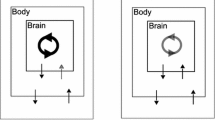Abstract
A half-center neural oscillator was coupled to a simple mechanical system to study the closed-loop interactions between a central pattern generator and its effector muscles. After a review of the open-loop mechanisms that were previously introduced by Skinner et al. (1994), we extend their geometric approach and introduce four additional closed-loop mechanisms by the inclusion of an antagonistic muscle pair acting on a mass and connected to the half-center neural oscillator ipsilaterally. Two of the closed-loop mechanisms, mechanical release mechanisms, have close resemblance to open-loop release mechanisms whereas the latter two, afferent mechanisms, have a strong dependence on the mechanical properties of the system. The results also show that stable oscillations can emerge in the presence of sensory feedback even if the neural system is not oscillatory. Finally, the feasibility of the closed-loop mechanisms was shown by weakening the idealized assumptions of the synaptic and the feedback connections as well as the rapidity of the oscillations.
Similar content being viewed by others
References
Bosco G, Poppele RE (2001) Proprioception from a spinocerebellar perspective. Physiological Reviews 81(2): 539–568.
Brown TG (1914) On the nature of the fundamental activity of the nervous centres, together with an analysis of the conditioning of rhythmic activity in progression, and a theory of evolution of function in the nervous system. J. Physiol. (London) 48: 18–46.
Dellow PG, Lund JP (1971) Evidence for central timing of rhythmical mastication. J. Physiol. 215: 1–13.
DiPrisco GV, Wallen P, Grillner S (1990) Synaptic effects of intraspinal stretch receptor neurons mediating movement-related feedback during locomotion. Brain Research 530: 161–166.
Ekeberg O, Grillner S (1999) Simulations of neuromuscular control in lamprey swimming. Phil. Trans. R. Soc. Lond. B 354: 895– 902.
Ermentrout B (2002) Simulating, Analyzing, and Animating Dynamical Systems: A Guide to XPPAUT for Researchers and Students. Society for Industrial and Applied Mathematics, Philadelphia, PA.
Feldman JL, Gautier H (1976) The interaction of pulmonary afferents and pneumotaxic center in control of respiratory pattern in cats. J. Neurophysiol. 39: 31–44.
Graham BP, Redman SJ (1993) Dynamic behaviour of a model of the muscle stretch reflex. Neural Networks 6: 947–962.
Grillner S (1981) Control of locomotion in bipeds, tetrapods, and fish. In: Papenheimer JR, Forster RE, Mammaerts W, Bullock TH, eds., Handbook of Physiology—The Nervous System II. American Physiological Society, Washington, D.C. pp. 1179– 1236.
Grillner S, Perret C, Zangger P (1976) Central generation of locomotion in the spinal dogfish. Brain Res. 109: 255–269.
Grillner S, Wallen P, Brodin L, Lansner A (1991) Neuronal network generating locomotor behavior in lamprey: Circuitry, transmitters, membrane properties, and simulation. Annu. Rev. Neurosci. 14: 169–199.
Hatsopoulos NG (1996) Coupling the neural and physical dynamics in rhythmic movements. Neural Computation 8: 567–581.
Henneman E, Olson CB (1965) Relations between structure and function in design of skeletal muscles J. Neurophysiol. 28(3): 581– 598.
Hill AV (1953) The Mechanics of Active Muscle. Proceedings of the Royal Society of London. Series B: Biological Sciences (London) 141: 104–117.
Hogan N (1990) Mechanical impedance of single- and multi-articular systems. In: Winters JM, Woo SLY, eds., Multiple Muscle Systems: Biomechanics and Movement Organization. Springer-Verlag, New York, pp. 149–164.
Kopell N, Somers D (1995) Anti-phase solutions in relaxation oscillators coupled through excitatory interactions. J. Math. Biol. 33: 261–280.
Lin CC, Segel LA, Handelman GH (1974) Mathematics Applied to Deterministic Problems in the Natural Sciences. Macmillan, New York.
Morris C, Lecar H (1981) Voltage oscillations in the barnacle giant muscle fiber. Biophys. J. 35: 193–213.
Proske U, Wise AK, Gregory JE (1999) Movement detection thresholds at the human elbow joint. Progress in Brain Research 123: 143–147.
Ramos CF, Stark LW (1990) Simulation experiments can shed light on the functional aspects of postural adjustments related to voluntary movements. In: Winters JM, Woo SLY, eds., Multiple Muscle Systems: Biomechanics and Movement Organization. Springer-Verlag, New York, pp. 507–517.
Rinzel J, Ermentrout B (1989) Analysis of neural excitability and oscillations. In: Koch C, Segev I, eds., Methods in Neuronal Modeling: From Synapses to Networks. MIT Press, Cambridge, MA, pp. 135–171.
Rossignol S, Lund JP, Drew T (1988) The role of sensory inputs in regulating patterns of rhythmical movements in higher vertebrates: A comparison between locomotion, respiration, and mastication. In: Cohen AH, Rossignol S, Grillner S, eds., Neural Control of Rhythmic Movements in Vertebrates. John Wiley & Sons, pp. 201–283.
Rowat P, Selverston A (1997) Oscillatory mechanisms in pairs of neurons connected with fast inhibitory synapses. Journal of Computational Neuroscience 4: 103–127.
Simoni MF (2002) Synthesis and analysis of a physical model of biological rhythmic motor control with sensorimotor feedback. Ph.D. thesis, School of Electrical and Computer Engineering, Georgia Institute of Technology.
Skinner FK, Kopell N, Marder E (1994) Mechanisms for oscillation and frequency control in reciprocally inhibitory model neural networks. Journal of Computational Neuroscience 1: 69– 87.
Taylor AL, Cottrell GW, Kristan WB (2002) Analysis of oscillations in a reciprocally inhibitory network with synaptic depression. Neural Computation 14(3): 561–581.
Terman D, Kopell N, Bose A (1998) Dynamics of two mutually coupled slow inhibitory neurons. Physica D 117: 241–275.
VanVreeswijk C, Abbott LF, Ermentrout GB (1994) When inhibition not excitation synchronizes neural firing. Journal of Computational Neuroscience 1(4): 313–321.
Wadden T, Ekeberg O (1998) A neuro-mechanical model of legged locomotion: Single leg control. Biological Cybernetics 79: 161–173.
Wang XJ, Rinzel J (1992) Alternating and synchronous rhythms in reciprocally inhibitory model neurons. Neural Computation 4: 84–97.
Author information
Authors and Affiliations
Corresponding author
Rights and permissions
About this article
Cite this article
Sekerli, M., Butera, R.J. Oscillations in a Simple Neuromechanical System: Underlying Mechanisms. J Comput Neurosci 19, 181–197 (2005). https://doi.org/10.1007/s10827-005-1537-y
Received:
Revised:
Accepted:
Issue Date:
DOI: https://doi.org/10.1007/s10827-005-1537-y




